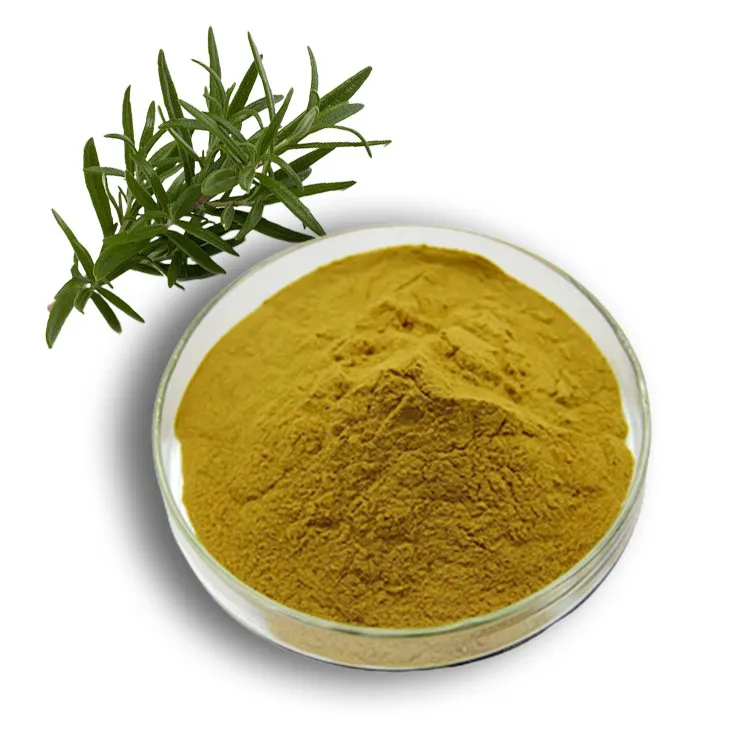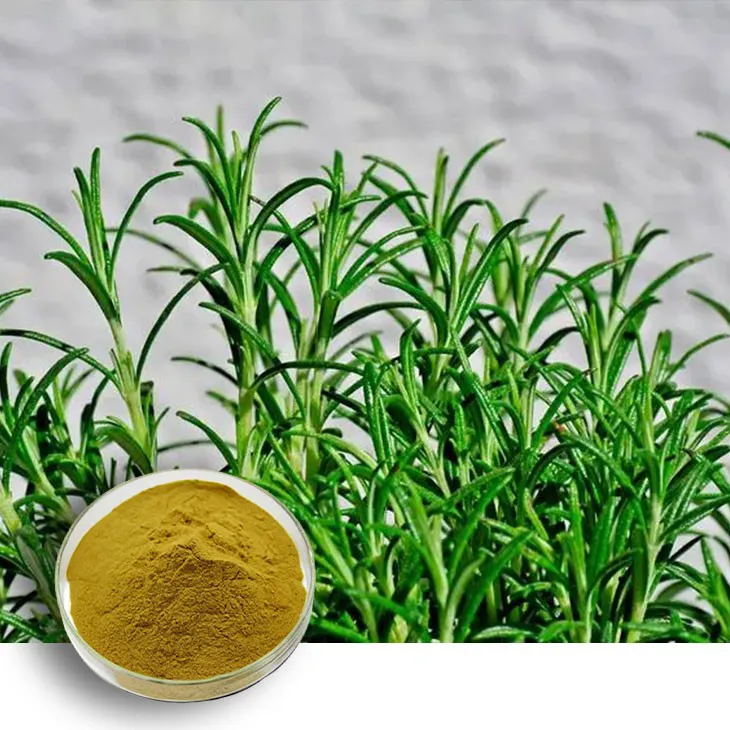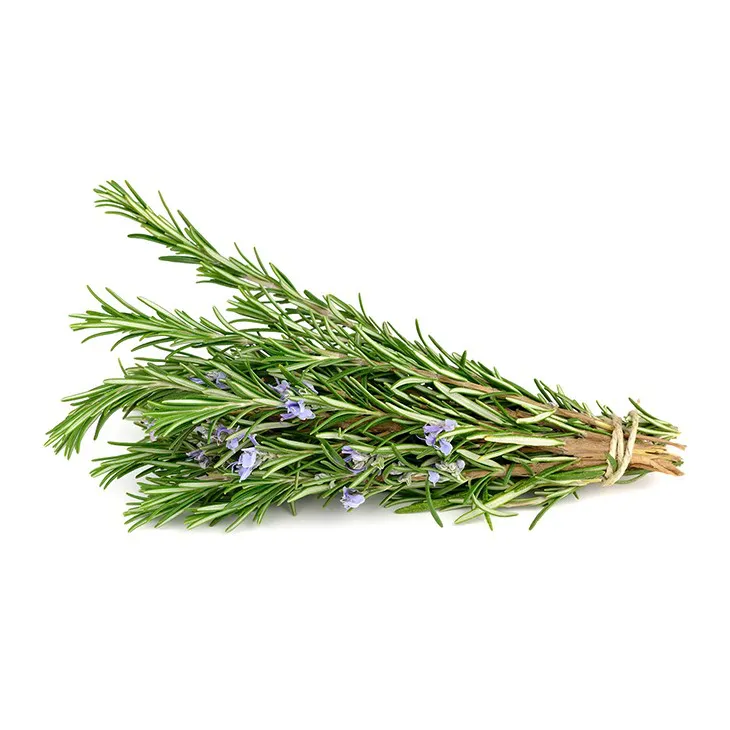- 0086-571-85302990
- sales@greenskybio.com
Rosemary Extract: From Leaves to Extraction.
2024-11-13

The Rosemary Plant and Its Leaves
The rosemary plant, scientifically known as Rosmarinus officinalis, is a well - known herb with a long history of use. Its leaves are the starting point for the production of Rosemary extract. These leaves are not only aesthetically pleasing with their needle - like shape and green color but also chemically rich.
The leaves of the rosemary plant contain a variety of chemical constituents. Terpenes are one of the major groups present. For example, cineole (also known as eucalyptol) gives rosemary its characteristic aroma. Another important group is the phenolic compounds, which include rosmarinic acid and carnosic acid. These phenolic compounds are particularly significant as they are associated with many of the potential health benefits and antioxidant properties of Rosemary extract.

Traditional Extraction Methods
1. Maceration
Maceration is one of the simplest and most traditional methods of extracting substances from plants. In the case of rosemary, the leaves are usually crushed or chopped finely and then soaked in a solvent. The solvent can be something like ethanol or olive oil. The crushed leaves are left in the solvent for an extended period, often several days to weeks. During this time, the chemical constituents from the leaves gradually dissolve into the solvent. One advantage of maceration is its simplicity. However, it can be a relatively slow process, and the extraction may not be as complete as with more modern methods.
2. Infusion
Infusion is another traditional approach. Here, hot water or a hot solvent is poured over the rosemary leaves. The heat helps to speed up the extraction process as it increases the solubility of the chemical constituents. This method is similar to making a tea. The rosemary leaves are steeped in the hot liquid for a certain period, usually a few minutes to an hour, depending on the desired strength of the extract. After steeping, the liquid is separated from the leaves, leaving behind an infusion that contains the extracted components. However, like maceration, infusion may not extract all of the valuable compounds from the rosemary leaves, especially those that are less soluble in water or the chosen solvent at the given temperature.
Modern Extraction Methods
1. Supercritical Fluid Extraction (SFE)
Supercritical fluid extraction has emerged as a more advanced and efficient method for obtaining Rosemary extract. In this process, a supercritical fluid, most commonly carbon dioxide (CO₂), is used as the solvent. The supercritical state of CO₂ occurs when it is subjected to specific temperature and pressure conditions that are above its critical point. In this state, CO₂ has properties that are intermediate between a gas and a liquid, which makes it an excellent solvent for extracting a wide range of compounds from the rosemary leaves. One of the main advantages of SFE is that it is a green extraction method as CO₂ is non - toxic, non - flammable, and can be easily removed from the extract, leaving behind a very pure product. Additionally, SFE can be precisely controlled in terms of temperature, pressure, and extraction time, allowing for a more targeted extraction of specific compounds.
2. Microwave - Assisted Extraction (MAE)
Microwave - assisted extraction is another modern technique. In MAE, the rosemary leaves are placed in a solvent and then subjected to microwave radiation. The microwaves cause the molecules in the solvent and the plant material to vibrate rapidly, which in turn generates heat. This heat helps to break down the cell walls of the rosemary leaves more quickly and efficiently, allowing the chemical constituents to be released into the solvent. MAE has the advantage of being a relatively fast extraction method compared to traditional methods. It can also be more energy - efficient as the heat is generated directly within the sample - solvent mixture, reducing overall energy consumption. However, careful control of the microwave power and extraction time is required to avoid over - extraction or degradation of the compounds.
Properties and Applications of Rosemary Extract
1. In the Pharmaceutical Sector
Rosemary extract has shown potential in the pharmaceutical field. Its antioxidant properties, mainly due to the presence of phenolic compounds like rosmarinic acid and carnosic acid, are of great interest. Antioxidants help to protect the body's cells from damage caused by free radicals. Some studies have suggested that rosemary extract may have anti - inflammatory effects as well. It could potentially be used in the development of new drugs or as a natural supplement to support overall health. For example, it may play a role in reducing oxidative stress in the body, which is associated with various chronic diseases such as heart disease, cancer, and neurodegenerative disorders.
2. In the Perfume and Aromatherapy Industries
In the perfume and aromatherapy industries, rosemary extract is highly valued for its unique and pleasant scent. The terpene components in the extract, such as cineole, contribute to its refreshing and herbal aroma. In perfumery, it can be used as a top note or middle note in fragrance compositions, adding a natural and earthy element. In aromatherapy, rosemary essential oil, which is a concentrated form of the extract, is often used for its invigorating and mood - enhancing properties. It is believed to help improve concentration, relieve stress, and boost mental clarity. When used in aromatherapy diffusers or in massage oils, the scent of rosemary can create a relaxing and rejuvenating atmosphere.
3. In the Food Industry
Rosemary extract is also used in the food industry. It can act as a natural preservative due to its antioxidant properties. By preventing the oxidation of fats and oils in food products, it helps to extend their shelf life. Additionally, it can be used as a flavoring agent, adding a subtle herbal and slightly spicy flavor to a variety of dishes. For example, it can be added to roasted meats, soups, and baked goods. In the production of some processed foods, rosemary extract can replace synthetic preservatives, appealing to consumers who prefer natural ingredients.
Quality Control and Standardization of Rosemary Extract
Ensuring the quality of rosemary extract is crucial for its various applications. Quality control begins with the selection of high - quality rosemary leaves. The leaves should be free from contaminants such as pesticides, heavy metals, and other impurities. During the extraction process, strict monitoring of parameters such as temperature, pressure (in the case of methods like SFE), and extraction time is necessary to ensure reproducibility and consistency of the extract.
Standardization of rosemary extract is also important. This involves determining the content of key chemical constituents, such as rosmarinic acid and carnosic acid, in the extract. Analytical techniques like high - performance liquid chromatography (HPLC) are often used to measure the levels of these compounds. By standardizing the extract, manufacturers can ensure that each batch of rosemary extract has a consistent composition and quality, which is essential for its reliable use in different industries.
The Future of Rosemary Extract
As research on rosemary extract continues, new potential applications are likely to be discovered. In the field of medicine, further studies may uncover more detailed mechanisms of its health - promoting effects, leading to the development of new therapeutic products. In the food and cosmetic industries, there may be an increasing demand for natural and sustainable ingredients, which could drive further innovation in the extraction and use of rosemary extract.
However, challenges also exist. For example, ensuring a stable supply of high - quality rosemary plants, especially in the face of environmental changes and potential pests or diseases, will be a concern. Additionally, as the market for rosemary extract grows, there will be a need for more stringent regulatory requirements to ensure product safety and quality. Overall, the future of rosemary extract looks promising, but it will require continued research, innovation, and regulatory oversight.
FAQ:
What are the main chemical constituents in rosemary leaves?
The rosemary leaves contain various chemical constituents such as phenolic diterpenes (e.g., carnosic acid and carnosol), flavonoids, and essential oils. These components contribute to the valuable properties of the rosemary extract.
What are the traditional extraction methods for rosemary extract?
Traditional extraction methods for rosemary extract may include solvent extraction using organic solvents like ethanol or methanol. Maceration, a process where the rosemary leaves are soaked in a solvent for an extended period, is also a traditional approach. Another method is steam distillation, which is mainly used to obtain the essential oil component of the rosemary extract.
What are the modern extraction methods for rosemary extract?
Modern extraction methods for rosemary extract include supercritical fluid extraction. In this method, a supercritical fluid (usually carbon dioxide) is used as the solvent. It offers advantages such as being more environmentally friendly, providing a purer extract, and having better selectivity compared to traditional solvent extraction methods. Another modern approach could be microwave - assisted extraction, which uses microwave energy to enhance the extraction process, reducing extraction time and potentially increasing the yield.
What potential health benefits does rosemary extract offer in the pharmaceutical sector?
Rosemary extract may have antioxidant properties in the pharmaceutical sector, which can help in preventing oxidative stress - related diseases. It may also have anti - inflammatory effects, potentially useful in treating conditions like arthritis. Some studies suggest that it could have antimicrobial properties, which might be beneficial in fighting certain infections. Additionally, there are indications that it could play a role in improving cognitive function, although more research is needed in this area.
How does rosemary extract contribute to the perfume and aromatherapy industries?
In the perfume and aromatherapy industries, rosemary extract provides a fresh, herbal, and slightly woody scent. It can be used as a top note or middle note in perfumery, adding a unique and pleasant aroma. In aromatherapy, the scent of rosemary extract is believed to have invigorating and stimulating effects, helping to improve focus and relieve stress.
Related literature
- The Chemical Composition and Biological Activity of Rosemary (Rosmarinus officinalis L.)"
- "Extraction Technologies for Rosemary Extract: A Review"
- "Rosemary Extract in Pharmaceutical Applications: Current Knowledge and Future Perspectives"
- "The Role of Rosemary Extract in Perfumery and Aromatherapy"
- ▶ Hesperidin
- ▶ citrus bioflavonoids
- ▶ plant extract
- ▶ lycopene
- ▶ Diosmin
- ▶ Grape seed extract
- ▶ Sea buckthorn Juice Powder
- ▶ Beetroot powder
- ▶ Hops Extract
- ▶ Artichoke Extract
- ▶ Reishi mushroom extract
- ▶ Astaxanthin
- ▶ Green Tea Extract
- ▶ Curcumin Extract
- ▶ Horse Chestnut Extract
- ▶ Other Problems
- ▶ Boswellia Serrata Extract
- ▶ Resveratrol Extract
- ▶ Marigold Extract
- ▶ Grape Leaf Extract
- ▶ blog3
-
Cranberry Plants and Skin - care Products.
2024-11-13
-
Polygonum Cuspidatum Extract
2024-11-13
-
Cassia Seed Extract
2024-11-13
-
Centella Asiatica Extract
2024-11-13
-
Chaste Berry Extract
2024-11-13
-
Polygonum multiflorum extract
2024-11-13
-
Beta Carotene
2024-11-13
-
Calendula Extract
2024-11-13
-
Echinacea Extract
2024-11-13
-
Lycopene
2024-11-13
-
Medicinal Marshmallow Extract
2024-11-13





















